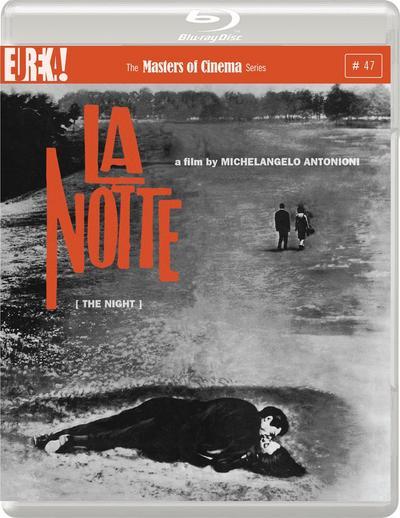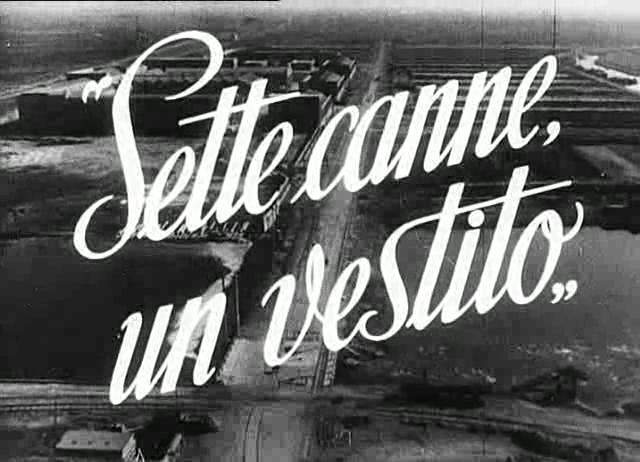Quote:
One of the masterworks of 1960s cinema, La notte [The Night] marked yet another development in the continuous stylistic evolution of its director, Michelangelo Antonioni — even as it solidified his reputation as one of the greatest artists of the 20th century. La notte is Antonioni’s “Twilight of the Gods”, but composed in cinematic terms. Examined from a crane-shot, it’s a sprawling study of Italy’s upper middle-class; seen in close-up, it’s an x-ray of modern man’s psychic desolation. Two of the giants of film-acting come together as a married couple living in crisis: Marcello Mastroianni (La dolce vita, 8 1/2) and Jeanne Moreau (Jules et Jim, Bay of Angels). He is a renowned author and “public intellectual”; she is “the wife”. Over the course of one day and the night into which it inevitably bleeds, the pair will come to re-examine their emotional bonds, and grapple with the question of whether love and communication are even possible in a world built out of profligate idylls and sexual hysteria.Read More »
Michelangelo Antonioni
-
Michelangelo Antonioni – La notte (1961)
1961-1970ArthouseDramaItalyMichelangelo Antonioni -
Michelangelo Antonioni – Le amiche AKA The Girlfriends (1955)
1951-1960DramaItalyMichelangelo AntonioniRomanceQuote:
Michelangelo Antonioni’s Le Amiche opens with an aerial shot of Turin, Italy that, in the moment, could easily be mistaken as simply a cheery, picturesque backdrop for the credits sequence. Retroactively, though, the image proves deceptive and even misleading in its suggestion of peace and tranquility. Antonioni’s 1955 film interrogates the detrimental socio-economic dimensions of modernity in Turin by moving an assortment of characters through confrontations and conversations in drawing rooms and cafés, and outside on beaches and in alleyways, so that a character’s elation or devastation must be understood in relation to the place where it occurs. Le Amiche is filled with characters asking one another “why” something is happening, but for the director, “where” is always the most optimal question.Read More » -
Michelangelo Antonioni – I vinti AKA The Vanquished (1953)
1951-1960CrimeDramaItalyMichelangelo AntonioniQuote:
A trilogy of stories of well-off youths who commit murders. In the French episode, a group of high school students kill one of their colleagues for his money. In the Italian episode, a university student’s involved in smuggling cigarettes. In the English episode, a lazy poet finds the body of a woman on the downs, and tries to sell his story to the press.Read More » -
Michelangelo Antonioni – Professione: reporter (1975)
1971-1980ArthouseDramaItalyMichelangelo AntonioniSynopsis
A frustrated war correspondent, unable to find the war he’s been asked to cover, takes the risky path of co-opting the I.D. of a dead arms dealer acquaintance.
IMDb.comRead More » -
Michelangelo Antonioni – L’Eclisse (1962)
1961-1970ArthouseDramaItalyMichelangelo AntonioniSynopsis :
Leaving her lover of four years, Vittoria starts an affair with a stockbroker. But as the film progresses, her emptiness becomes more obvious, echoed in the buildings and the landscape, and she finally decides on a life of solitude rather than marriage or a failing relationship. Completing what is now seen as a trilogy of films on alienation after The Adventure and The Night, The Eclipse paints a picture of how modern industrial society can obliterate the emotions between men and women. Antonioni uses his symbols boldly: the final shots – 52 of them – hauntingly reflect a city empty of life.Read More » -
Michelangelo Antonioni – Identificazione di una donna AKA Identification of a Woman (1982)
1981-1990ArthouseDramaItalyMichelangelo AntonioniMichelangelo Antonioni’s Identification of a Woman is a body- and soul-baring voyage into one man’s artistic and erotic consciousness. After his wife leaves him, a film director finds himself drawn into affairs with two enigmatic women: at the same time, he searches for the right subject and actress for his next film. This spellbinding antiromance was a late-career coup for the legendary Italian filmmaker, and is renowned for its sexual explicitness and an extended scene on a fog-enshrouded highway that stands with the director’s greatest set pieces (-Criterion)Read More »
-
Michelangelo Antonioni – La signora senza camelie AKA The Lady Without Camelias [+Extras] (1953)
1951-1960ArthouseDramaItalyMichelangelo AntonioniClara Manni (Lucia Bosé, so good in Antonioni’s A Story of a Love Affair), a Milan shop girl, is discovered on the street and used for a bit part in a movie. That single part brings her immediate celebrity, and with the coaxing of her producer, Gianni, she becomes a screen sex symbol. She has great success in several sex comedy vehicles, but Gianni decides to push her into the world of the art film in order to attain artistic legitimacy and respect. She never wishes for this, since money is never an issue to her, but she is pushed head first into a production of Joan of Arc. The film is brutally attacked by the critics, and Clara’s dignity and identity are thrown into question in the harrowing final shot.Read More »
-
Michelangelo Antonioni – Sette canne, un vestito (1949)
1941-1950DocumentaryItalyMichelangelo AntonioniShort Filmshort documentary on the production of rayon, shot in Torviscosa (Italy). It portrays the production of this new synthetic fabric in the small town of Torviscosa, entirely built following strict fascist canons.Read More »
-
Michelangelo Antonioni – Lo Sguardo di Michelangelo AKA Michelangelo Eye to Eye (2004)
2001-2010ArthouseItalyMichelangelo AntonioniShort FilmSilentQuote:
By the time Michelangelo Antonioni released Michelangelo Eye to EyeBeyond the Clouds in 1995, his keen sense of patient, intimate observation had seemed to give way to a kind of leering, gratuitous voyeurism in the film’s repeated, over-lingering shots of the female form. It is, however, precisely this painstaking attention to the voluptuousness of form and tactileness of surfaces that makes his subsequent short film, Michelangelo Eye to Eye particularly sensual and textural in its execution. Prefaced with a text description of the filmmaker’s recent health problems (in particular, a debilitating stroke that left him partially paralyzed), the film opens with a shot of a frail Antonioni emerging from the shadows as he walks in slow, awkward gait into an unpopulated hall where Michelangelo Buonarotti’s marble statue of Moses – a scaled down version of an ambitiously conceived wall tomb for Pope Julius II – is once again in display after a period of meticulous restoration. Composed of a series of detailed observations of the sculpture’s composition from several camera angles and vantage points, Antonioni continually refocuses to the shot of Moses’ opaque gaze – an image that is sublimely matched by the filmmaker’s own occluded, returned gaze as he examines the object of his attention through limpid, watery eyes. In addition to creating a thorough, meticulous, and deliberative objective study of the Renaissance sculpture’s robust physical form and timeless, universal beauty, Antonioni’s juxtaposition of his own weakened, aging frame against the larger-than-life sculpture of Moses creates an indelible, thoughtful, and poignant image on human frailty, transience, creative compromise, and the enduring legacy of – and mortal transcendence through – enlightened art.
filmref.comRead More »









